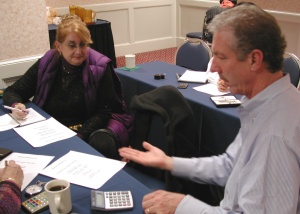On January 12, 2010, the DC Chapter of the GIA Alumni Association was privileged to hear from Mr. Michael Goldstein, an internationally recognized authority on antique-cut diamonds.
His presentation explored the world of these unique gemstones from both an informational and an interactive perspective.
The evening commenced with the principal informational component, which focused both on the physical and technological characteristics of the diamonds themselves and on the historical development of the marketplace in which they are bought and sold. The lecture was structured first to introduce each of the primary types of antique-cut stones with a description of its appearance and a profile of its waxing and waning role in the trade.
 Old Mine stones, with off-round or cushion-shaped outlines; Old European diamonds, with round shapes; and rose cuts, with flat bases and faceted domes, were each highlighted. Each type was initially brought to the market by particular developments in diamond supply and cutting technology, enjoyed a period of popularity, experienced a fall from grace (and often became a victim of recutting), and has more recently seen a resurgence of interest.
Old Mine stones, with off-round or cushion-shaped outlines; Old European diamonds, with round shapes; and rose cuts, with flat bases and faceted domes, were each highlighted. Each type was initially brought to the market by particular developments in diamond supply and cutting technology, enjoyed a period of popularity, experienced a fall from grace (and often became a victim of recutting), and has more recently seen a resurgence of interest.
 Given the current popularity of antique diamonds, and the resultant influx of recently manufactured “old” cuts, the discussion then turned to identifying features that can assist in distinguishing the genuine from the new. Characteristic attributes of genuine stones can include, for instance, yellowish coloration, chipped appearance, and, critically, knife-edged girdles. Nonetheless, with these characteristics came the repeated caveat that exceptions abound and today’s efforts are becoming ever more sophisticated.
Given the current popularity of antique diamonds, and the resultant influx of recently manufactured “old” cuts, the discussion then turned to identifying features that can assist in distinguishing the genuine from the new. Characteristic attributes of genuine stones can include, for instance, yellowish coloration, chipped appearance, and, critically, knife-edged girdles. Nonetheless, with these characteristics came the repeated caveat that exceptions abound and today’s efforts are becoming ever more sophisticated.
 Additionally, woven throughout the presentation was the concept of valuing antique-cut stones, and it was noted that any discussion of the present market value of an antique diamond must take into account not only resale as is but also the idea of recutting and attendant issues such as damage and weight loss.
Additionally, woven throughout the presentation was the concept of valuing antique-cut stones, and it was noted that any discussion of the present market value of an antique diamond must take into account not only resale as is but also the idea of recutting and attendant issues such as damage and weight loss.
 Valuation likewise provided a segue to the interactive component of the evening, which focused on weight estimation of antique-cut diamonds. Attendees had the opportunity to attempt measuring actual stones, unmounted and mounted, and applying the weight estimation formulas recommended by Mr. Goldstein for each of the three primary old-cut types referenced above. The DCGIA Chapter truly had the opportunity to learn from one of the foremost experts in the trade. Thank you, Mr. Goldstein.
Valuation likewise provided a segue to the interactive component of the evening, which focused on weight estimation of antique-cut diamonds. Attendees had the opportunity to attempt measuring actual stones, unmounted and mounted, and applying the weight estimation formulas recommended by Mr. Goldstein for each of the three primary old-cut types referenced above. The DCGIA Chapter truly had the opportunity to learn from one of the foremost experts in the trade. Thank you, Mr. Goldstein.
Summary prepared by Andrea Blake, G.G.


